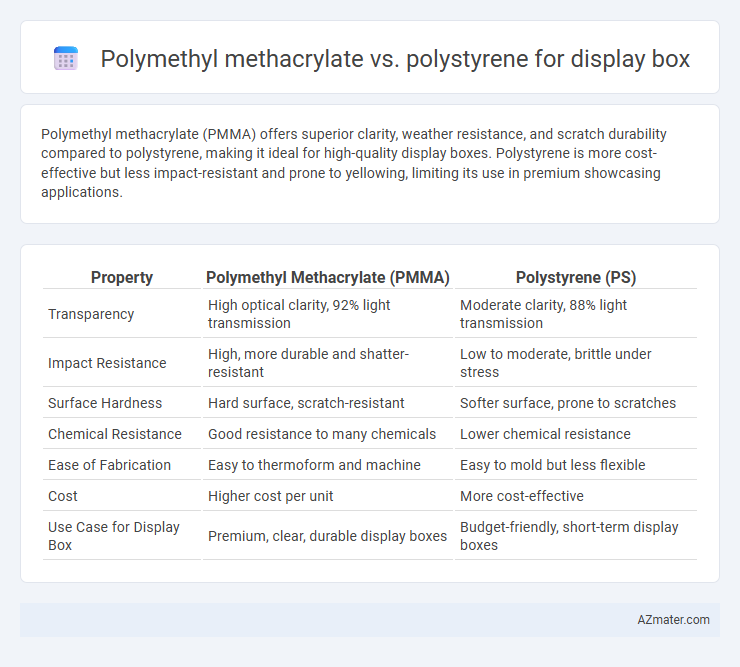Polymethyl methacrylate (PMMA) offers superior clarity, weather resistance, and scratch durability compared to polystyrene, making it ideal for high-quality display boxes. Polystyrene is more cost-effective but less impact-resistant and prone to yellowing, limiting its use in premium showcasing applications.
Table of Comparison
| Property | Polymethyl Methacrylate (PMMA) | Polystyrene (PS) |
|---|---|---|
| Transparency | High optical clarity, 92% light transmission | Moderate clarity, 88% light transmission |
| Impact Resistance | High, more durable and shatter-resistant | Low to moderate, brittle under stress |
| Surface Hardness | Hard surface, scratch-resistant | Softer surface, prone to scratches |
| Chemical Resistance | Good resistance to many chemicals | Lower chemical resistance |
| Ease of Fabrication | Easy to thermoform and machine | Easy to mold but less flexible |
| Cost | Higher cost per unit | More cost-effective |
| Use Case for Display Box | Premium, clear, durable display boxes | Budget-friendly, short-term display boxes |
Introduction to Polymethyl Methacrylate and Polystyrene
Polymethyl methacrylate (PMMA), commonly known as acrylic, offers superior optical clarity and UV resistance, making it ideal for high-end display boxes requiring long-term durability and transparency. Polystyrene (PS), a more cost-effective thermoplastic, provides good dimensional stability and ease of fabrication but lacks the impact strength and weather resistance of PMMA. Choosing between PMMA and PS depends on the balance between clarity, durability, and budget constraints for display applications.
Material Properties and Composition Comparison
Polymethyl methacrylate (PMMA) offers superior optical clarity and UV resistance compared to polystyrene, making it ideal for high-quality display boxes requiring long-term transparency and durability. PMMA's composition of methyl methacrylate monomers results in a rigid, scratch-resistant material with excellent weatherability, whereas polystyrene, derived from styrene monomers, tends to be more brittle and less resistant to yellowing under UV exposure. The enhanced mechanical strength and chemical stability of PMMA provide a significant advantage over polystyrene in display applications demanding premium visual appeal and material longevity.
Optical Clarity and Transparency Differences
Polymethyl methacrylate (PMMA) offers superior optical clarity with light transmittance up to 92%, making it ideal for display boxes that require high transparency and brilliance. Polystyrene (PS), while more cost-effective, typically has lower light transmittance around 85% and exhibits more haze, reducing overall transparency and visual sharpness. The enhanced clarity of PMMA ensures better visibility of displayed items, whereas PS is more prone to yellowing and scratching, impacting long-term display quality.
Impact Resistance and Durability
Polymethyl methacrylate (PMMA) offers superior impact resistance compared to polystyrene, making it less prone to cracking or shattering under stress. PMMA's enhanced durability ensures long-lasting clarity and resistance to UV degradation, whereas polystyrene tends to yellow and become brittle over time. For display boxes requiring robust protection and extended lifespan, PMMA is the preferred material due to its combination of toughness and environmental stability.
Weight and Handling of Display Boxes
Polymethyl methacrylate (PMMA) offers significantly lighter weight compared to polystyrene, making it easier to handle and transport for display boxes. Its superior strength-to-weight ratio ensures that PMMA display boxes remain durable while reducing overall weight, enhancing user convenience during setup and relocation. Polystyrene, although cost-effective, tends to be heavier and more brittle, which can complicate handling and increase the risk of damage during frequent movement.
UV Stability and Weather Resistance
Polymethyl methacrylate (PMMA) exhibits superior UV stability and weather resistance compared to Polystyrene, making it more suitable for display boxes exposed to sunlight and outdoor conditions. PMMA resists yellowing and maintains clarity over prolonged UV exposure, whereas Polystyrene tends to degrade, becoming brittle and discolored when subjected to UV rays. For durable and visually appealing display cases in harsh environments, PMMA is the preferred material due to its enhanced longevity and optical properties.
Machinability and Fabrication Flexibility
Polymethyl methacrylate (PMMA) offers superior machinability compared to polystyrene, allowing precise cutting, drilling, and shaping with minimal risk of cracking or chipping, which is crucial for high-quality display box fabrication. PMMA also provides greater fabrication flexibility due to its ease of thermoforming and ability to be polished to a high-gloss finish, enhancing visual appeal and durability. Polystyrene, while cost-effective, is more brittle and less adaptable in complex machining or thermoforming processes, limiting its use for intricate or premium display box designs.
Cost Considerations and Availability
Polymethyl methacrylate (PMMA) generally costs more than polystyrene due to its superior clarity, UV resistance, and durability, making it a premium choice for high-quality display boxes. Polystyrene is more budget-friendly and widely available, offering adequate transparency but lower impact resistance and susceptibility to yellowing over time. Availability of polystyrene is higher in bulk quantities, whereas PMMA supply can be more limited depending on grade and specifications, influencing overall project cost and feasibility.
Common Applications in Display Boxes
Polymethyl methacrylate (PMMA) is widely used in display boxes for its excellent clarity, UV resistance, and durability, making it ideal for showcasing high-value items such as jewelry, electronics, and collectibles. Polystyrene, while less transparent and more brittle than PMMA, is favored for cost-effective, short-term display solutions like promotional packaging and point-of-sale displays. Both materials offer lightweight properties, but PMMA's superior optical quality and impact resistance make it the preferred choice for premium and long-lasting display boxes.
Choosing the Right Material for Your Display Box Needs
Polymethyl methacrylate (PMMA) offers superior clarity, UV resistance, and impact strength compared to polystyrene, making it ideal for high-quality, durable display boxes. Polystyrene is more cost-effective and lightweight but lacks the durability and scratch resistance of PMMA, suitable for short-term or low-budget displays. Selecting between PMMA and polystyrene depends on prioritizing factors such as optical clarity, weather resistance, budget, and expected lifespan of the display box.

Infographic: Polymethyl methacrylate vs Polystyrene for Display box
 azmater.com
azmater.com